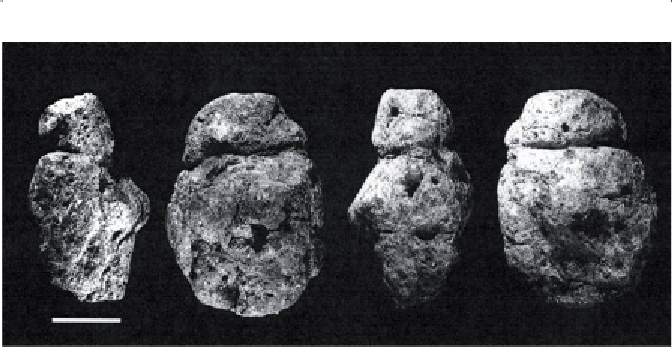Travel Reference
In-Depth Information
Figure 128
Four views of the Berekhat Ram fi gurine, possibly the oldest representation of
a human form yet discovered. The scale represents 1 centimeter. (From Francesco d'Errico
and April Nowell, “A New Look at the Berekhat Ram Figurine, Implications for the Origins of
Symbolism,”
Cambridge Archaeological Journal
10 (2000): 123-67, Figure 1.) Courtesy of
Francesco d'Errico/
Cambridge Archaeological Journal
.
Consider the “Venus of Berekhat Ram” that was discovered in 1981 at a dig
in northern Israel. This little stone fi gurine looks like a cruder version of the
voluptuous female fi gures that have been found from late Stone Age sites at
various places around the Mediterranean. These later venuses, however, are
a few thousand years old, while the Berekhat Ram fi gure was found sand-
wiched between two layers of volcanic ash that clearly assign it an age of a
quarter of a million years.
Microscopic and electron microscope examination showed that the
Berekhat Ram fi gure had indeed been shaped and incised by tools in several
places, though the authors are careful to point out that it may not actually be
a fi gurine. Was this ancient Venus really a representation of a zaftig female
form? Or was somebody, presumably a
H. erectus
, simply noodling around
with a piece of rock? A defi nitive answer awaits similar discoveries.
It is clear from the surveys and discoveries of McBrearty and Brooks that
many important cultural advances really did not originate in Europe. Knife-
like stone blades, obviously the work of humans, have been found at sites in
several parts of Africa that go back at least 300,000 years. These blades are
too small and narrow to be held comfortably in the hand. Rows of the blades
were probably embedded in wood using pitch or resin, to produce a sharp


